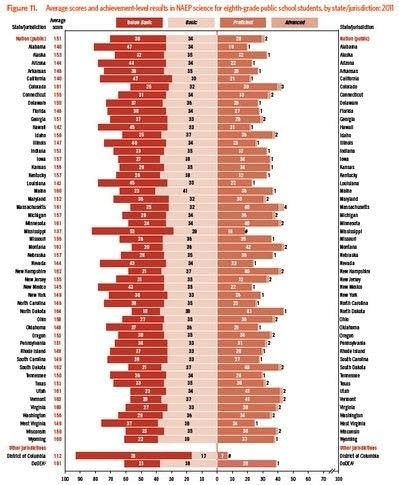We’re not exactly the ‘science state’

Go Deeper.
Create an account or log in to save stories.
Like this?
Thanks for liking this story! We have added it to a list of your favorite stories.
Scores for science tests for 8th graders in the nation were released today. Minnesota's performance was relatively mediocre with no significant improvement over previous test scores. The state is near the top of the list of states where the tests were administered, but there's little room for pride in the results.
Frighteningly, 24 percent of Minnesota 8th graders are below basic understanding of science and 60 percent are not considered proficient.
How bad is that? Here are some of the sample questions (take the quiz here)
Turn Up Your Support
MPR News helps you turn down the noise and build shared understanding. Turn up your support for this public resource and keep trusted journalism accessible to all.
What atoms combine to make up a molecule of water?
A. 1 hydrogen, 1 oxygen
B. 1 hydrogen, 2 oxygen
C. 2 hydrogen, 1 oxygen
D. 2 hydrogen, 2 oxygen
Which characteristic is shared by all cells?
A. They need energy.
B. They reproduce sexually.
C. They make their own food.
D. They move from place to place.
The diagram below shows the collision of two tectonic plates in Asia.
[image]
Diagram showing the collision of two tectonic plates in Asia. A rectangular shape is divided in half by a drawing of mountains labeled "Himalayas. To the left of the mountains is an open area with no label; underneath this area are the words "Indian Plate" with an arrow pointing to the right. To the right of the mountains is an open area labeled "Tibetan Plateau." Under this plateau are the words "Eurasian Plate" with an arrow pointing to the left.
What is a result of this collision?
A. Volcanoes erupt periodically.
B. The Tibetan Plateau slowly sinks.
C. The Himalayas increase in height each year.
D. Glaciers on the Tibetan Plateau melt.
Water evaporates and falls back to Earth as rain or snow. What is the primary energy source that drives this cycle?
A. The wind
B. The Sun
C. Air pressure
D. Ocean currents
Dear reader,
Your voice matters. And we want to hear it.
Will you help shape the future of Minnesota Public Radio by taking our short Listener Survey?
It only takes a few minutes, and your input helps us serve you better—whether it’s news, culture, or the conversations that matter most to Minnesotans.



